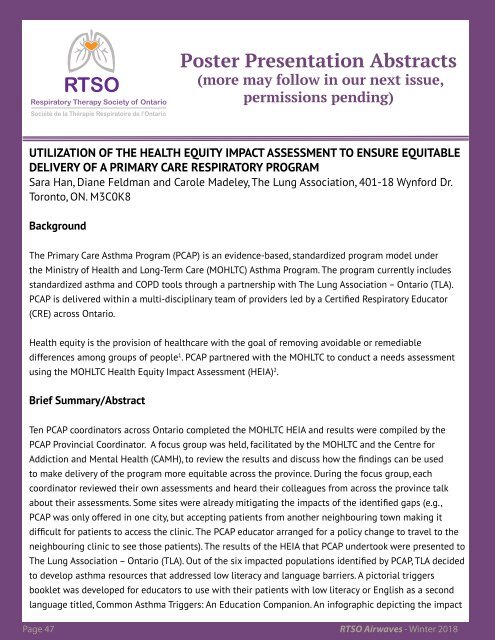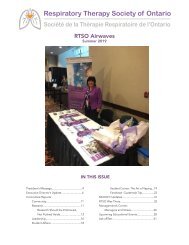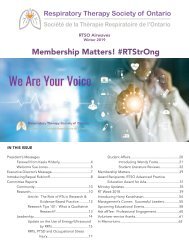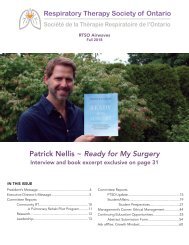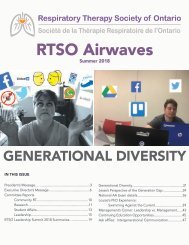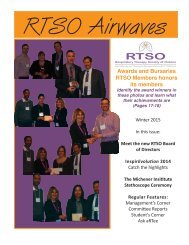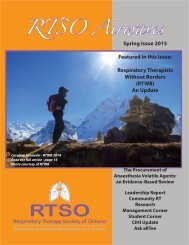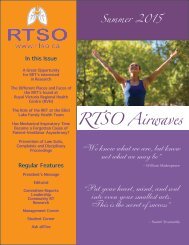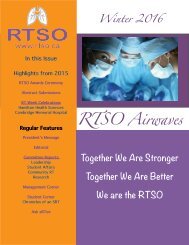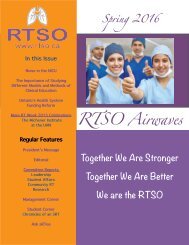Airwaves Winter 2018
Create successful ePaper yourself
Turn your PDF publications into a flip-book with our unique Google optimized e-Paper software.
RTSO<br />
Poster Presentation Abstracts<br />
(more may follow in our next issue,<br />
permissions pending)<br />
UTILIZATION OF THE HEALTH EQUITY IMPACT ASSESSMENT TO ENSURE EQUITABLE<br />
DELIVERY OF A PRIMARY CARE RESPIRATORY PROGRAM<br />
Sara Han, Diane Feldman and Carole Madeley, The Lung Association, 401-18 Wynford Dr.<br />
Toronto, ON. M3C0K8<br />
Background<br />
The Primary Care Asthma Program (PCAP) is an evidence-based, standardized program model under<br />
the Ministry of Health and Long-Term Care (MOHLTC) Asthma Program. The program currently includes<br />
standardized asthma and COPD tools through a partnership with The Lung Association – Ontario (TLA).<br />
PCAP is delivered within a multi-disciplinary team of providers led by a Certified Respiratory Educator<br />
(CRE) across Ontario.<br />
Health equity is the provision of healthcare with the goal of removing avoidable or remediable<br />
differences among groups of people 1 . PCAP partnered with the MOHLTC to conduct a needs assessment<br />
using the MOHLTC Health Equity Impact Assessment (HEIA) 2 .<br />
Brief Summary/Abstract<br />
Ten PCAP coordinators across Ontario completed the MOHLTC HEIA and results were compiled by the<br />
PCAP Provincial Coordinator. A focus group was held, facilitated by the MOHLTC and the Centre for<br />
Addiction and Mental Health (CAMH), to review the results and discuss how the findings can be used<br />
to make delivery of the program more equitable across the province. During the focus group, each<br />
coordinator reviewed their own assessments and heard their colleagues from across the province talk<br />
about their assessments. Some sites were already mitigating the impacts of the identified gaps (e.g.,<br />
PCAP was only offered in one city, but accepting patients from another neighbouring town making it<br />
difficult for patients to access the clinic. The PCAP educator arranged for a policy change to travel to the<br />
neighbouring clinic to see those patients). The results of the HEIA that PCAP undertook were presented to<br />
The Lung Association – Ontario (TLA). Out of the six impacted populations identified by PCAP, TLA decided<br />
to develop asthma resources that addressed low literacy and language barriers. A pictorial triggers<br />
booklet was developed for educators to use with their patients with low literacy or English as a second<br />
language titled, Common Asthma Triggers: An Education Companion. An infographic depicting the impact<br />
Page 47 RTSO <strong>Airwaves</strong> - <strong>Winter</strong> <strong>2018</strong>


